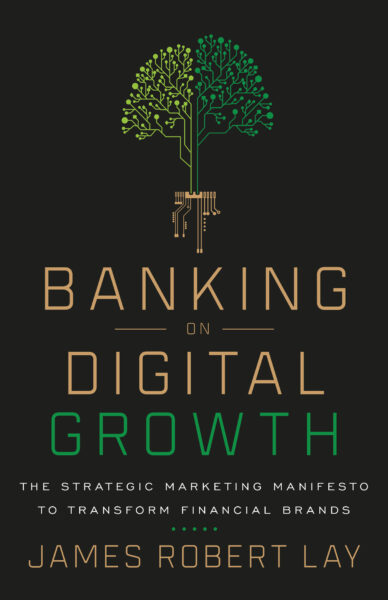The financial industry is experiencing exponential change fueled by new technologies. Today’s consumers make purchase decisions long before they walk into a physical branch location, if they walk into a branch at all, while mobile banks, digital lenders, and fintechs have transformed traditional growth models rooted in legacy broadcast marketing and branch sales strategies.
Financial brands that have only dabbled in digital marketing without a formal plan or strategy to guide them are now feeling frustrated because they haven’t gotten the results they want.

James Robert Lay wrote Banking on Digital Growth: The Strategic Marketing Manifesto to Transform Financial Brands to offer brands newfound clarity. He shares a strategic blueprint framed around twelve key areas of focus that allows financial brands to confidently generate 10X more loans and deposits while proving the value of marketing as a strategic growth leader—not a cost center. I recently caught up with James to learn what inspired him to write the book, his favorite idea that he shares, and how that idea has impacted his work with clients.
What happened that made you decide to write the book? What was the exact moment you realized you needed to get these ideas out there?
The idea for this book goes back to 2012, when we started seeing some patterns around how financial brands were operating and planning to grow. What we noticed was that digital was not a primary consideration for brands back then. In 2014 and 2015, we spent six figures to develop a diagnostic framework that became the Digital Growth Blueprint. Once we had this diagnostic framework, we started doing quantifiable research around where financial brands were.
Over the past five years, the financial brands that had properly planned to maximize their digital growth potential were few and far between. In fact, we were starting to see a digital divide with the haves and the have-nots on either side, with the have-not side making up about 85%.
I took everything I’d learned through direct and secondary observation, and primary and secondary studies, and put it all together for this book. It’s a call to action for financial brands to deeply consider their digital growth strategies, especially in a post COVID-19 world.
What’s your favorite specific, actionable idea in the book?
Financial brands have to reposition themselves in the marketplace beyond the promotion of commoditized great rates, amazing service, and a lookalike list of product features. When we look at that type of a go-to-market strategy, a financial brand views itself as the hero in the stories it tells about itself, its employees, and the people within the communities it serves.
Financial brands have an opportunity to rise above that commoditization by changing the stories they tell. Money is stressful, and that stress takes a toll on people’s health, relationships, and their overall sense of wellbeing. What people want more than anything is a guide they can trust to move them beyond that stress toward a bigger, better, and brighter future. Financial brands must shift their role in the story to being Obi-Wan Kenobi, Gandalf, and Mr. Miyagi.
Doing that requires a methodical approach that starts with having some tough conversations with individual teams or perhaps the organization as a whole. More than likely, a brand will need to redefine its purpose to explain how it will help people post COVID-19 and beyond.

What’s a story of how you’ve applied this strategy with one of your own clients? What did you do for them?
In 2014, a financial brand we’d been advising called us and said they’d like our help building a new website. Once we actually dug into what they wanted, however, we discovered that a website wasn’t really what they needed. That would’ve merely been a Band-Aid over a gaping wound. What they really needed was a digital growth strategy for the next five years.
We ran them through our digital growth diagnostic framework and identified a lot of gaps, friction, pain points, and challenges that needed to be eliminated. But at the same time, we also identified multiple opportunities that could be created or captured over the coming years. It was important, though, to communicate to the marketing team, the leadership team, and the board of directors that this effort was going to take time for them to work through. It wasn’t going to happen overnight, although they would experience some wins every step of the way.
As we started this digital growth journey, the marketing team—which had been viewed as a glorified in-house Kinkos—started to gain respect. They developed a website that sells and marketing automation that solved their digital growth numbers. The amount of leads that were coming in through the website increased by 1,500%. They were generating around $2.5 million in new net interest income over the course of about eighteen months that they previously didn’t have the ability to capture. Over the next two to three years, their digital channel, which had been their most underperforming channel, jumped ahead of their dozen physical branch locations. Digital became the top channel for new account growth and loan growth.
Since that time, this financial brand has continued to revise and optimize their strategy based on changing consumer behavior. During this pandemic, they have a stance of confidence and they’re able to communicate that confidence to the people in the communities that they serve. They’re continuing to build upon the foundations that they’ve laid over the past five years.
The future is brighter than it’s ever been for this brand because they did the hard work and made the hard choices. They were committed to making progress every step of the way and keeping their focus where it needed to be. They haven’t been discouraged sometimes when things felt a little bit uncomfortable. When we’re talking about digital growth and some of the transformations that have to happen to realize the creation of this new future, it can be a bit scary. But it doesn’t have to be, and that’s why it’s exactly why I wrote this book.